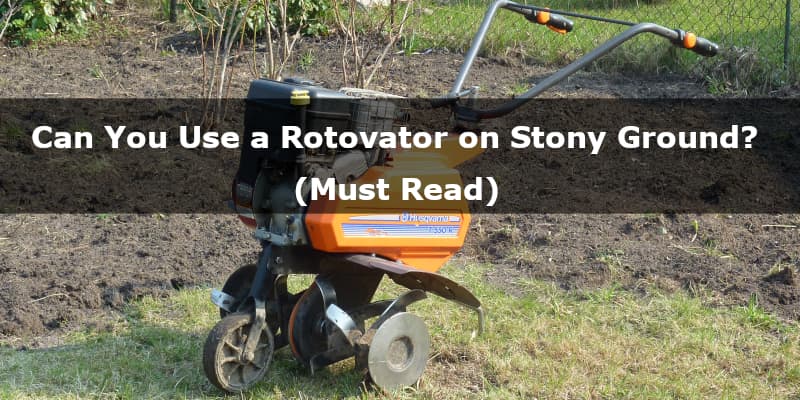So, you have stony ground, and you don’t know if you can use your rotovator?
In this post, you will learn everything about rotovating on stony ground.
Can You Use a Rotovator on Stony Ground?
It’s not recommended to use a rotovator on stony ground. Big stones might injure you, and damage the rotovator. Before rotovating on stony ground, you should remove all the bigger stones.
Using rotovator on the ground that contains big stones will never be successful. You will likely be injured, or you will break your rotovator.
Because of that, always remove the stones first, and then you can rotovate.
Is it Dangerous to Use a Rotovator on Stony Ground?
Using rotavator on the stony ground is dangerous for you because rotovator might launch stones back at you, and get you injured.
When you rotovate on stony ground, there is a high chance that you stumble upon multiple stones. A rotovator will split some stones, and force them into the ground. However, not in each case.
Most of the time, the rotovator will throw away stones in many directions. The possibility that some of them hits you is very high.
A rotovator might throw away stones at different speeds. Some of them might even fly at the speed of 50 mph (80 km/h). You can only imagine what such a stone might do to you. Using a helmet, or protective glasses might help you, but other parts of your body are still vulnerable.
Can You Damage Your Rotovator on Stony Ground?
Using a rotovator on stony ground is dangerous not only for you, but it can damage some parts of your rotovator.
Rotovating stones is dangerous for your rotovator. It might damage parts, like:
- Pipes
- Gas maine
- Cables
If you have your own rotovator, the costs of fixing a rotovator might be really high. Depending on the part damage, the costs of fixing a rotovator vary from $50 to even $200.
If you rent a rotovator, and damage it, the lessor will also charge you even more.
That being said, it’s totally not worth it to use a rotovator on stony ground.
Related: Can You Overtill a Garden? What are the Consequences?
What’s the Best Way to Use a Rotovator on Stony Ground?
Using a rotovator on the stony ground is possible, but only if you remove bigger stones. There are two main ways of removing stones from the ground.
The first way is to remove the stones by yourself. All you need to do is dig your ground up, and handpick all the bigger stones.
It might take a few hours, but it’s definitely worth it. All you need is a shovel, a wheelbarrow, and a pair of gloves. Dig 10 to 12 inches into the soil and handpick all the bigger stones. As a rule of thumb, the stones bigger than 1.2 inches (3 cm) should be removed. The smaller ones should be crushed by your rotovator.
However, it only applies when the area that you want to rotovate is small. You need to decide whether it’s worth it, or it will take too much time and effort.
If the area is bigger, you can think of renting a rock picker. It’s an implement to sieve through the top layer of soil to separate and collect rocks and soil debris from good topsoil. It’s usually pulled by a tractor or other vehicles, so it makes sense only if you have bigger area to rotovate. This method is used mostly on farmlands, and construction sites.
Big stones should be removed not only because they are dangerous, but also because they block roots from reaching their necessary resources for proper growth, and take up growing space that plants need.
Once you remove the big stones, you can rotovate the ground. It’s possible that smaller stones will be still present in the ground, but they aren’t dangerous, and your rotovator should be able to smash them.
What Type of Rotovator is the Best to Use on Stony Ground?
A rotovator for tough soil that contains even small stones, should be equipped with a gasoline engine, of at least 40 cc. It will provide enough power to churn up challenging terrain.
You should avoid rotovators with electric engines because they might not have enough power. They’re good for loamy, sandy, and aerated soils. A heavy-duty rotavator is all you should be looking for.
When choosing between 2 vs. 4- stroke engines, I’d go with 2-stroke engines, because they have better torque at high speeds, which makes it easier to crush stones.
Also, use a rotovator with a working width of at least 12 inches (30 cm) and a tilling depth of at least 8 inches (20 cm) to avoid spending more time on the job than necessary.
Rotavators for stony ground should be equipped with a safety switch to avoid unnecessary accidents. If the blades hit something that they shouldn’t, the safety switch should be located at the handles for easy accessibility to stop the motor from operating
Sources
triginer.com, donotdisturbgardening.com, diygarden.co.uk, pyracantha.co.uk

